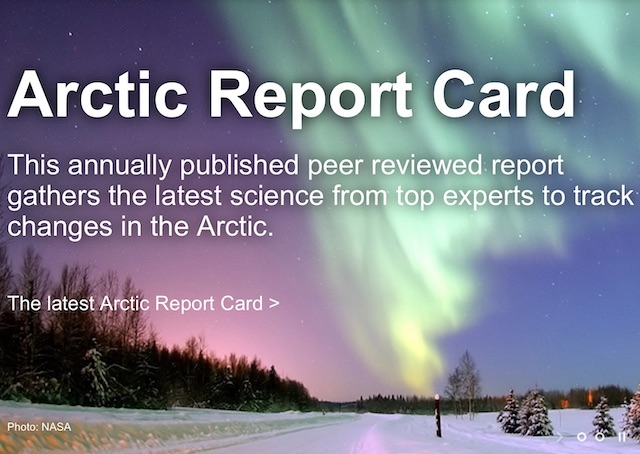
The 2019 Arctic Report card is out. Well yes, I’m a few days behind, it was published on 10th Dec at the AGU.
For those wondering what this is, permit me to explain. This Report Card is an annual volume of original, peer-reviewed environmental observations and analysis of a region undergoing rapid and dramatic change. Compiled by 81 scientists from 12 nations, the 2019 report card tracks a number of environmental indicators to inform decisions by local, state and federal leaders, as Arctic residents confront the challenges and opportunities presented by a rapidly changing climate and ecosystem. This latest 14th edition for 2019 was released on at the American Geophysical Union’s fall meeting on 10th Dec.
Key Message: Arctic ecosystems and communities are increasingly at risk due to continued warming and declining sea ice
The Arctic marine ecosystem and the communities that depend upon it continue to experience unprecedented changes as a result of warming air temperatures, declining sea ice, and warming waters. Arctic Report Card 2019 draws particular attention to the Bering Sea region, where declining winter sea ice exemplifies the potential for sudden and extreme change. Indigenous Elders from the Bering Sea region offer their experiences of living at the forefront of climate change.
12 key Major Findings for 2019

- The average annual land surface air temperature north of 60° N for October 2018-August 2019 was the second warmest since 1900. The warming air temperatures are driving changes in the Arctic environment that affect ecosystems and communities on a regional and global scale.
On the Land …
- The Greenland Ice Sheet is losing nearly 267 billion metric tons of ice per year and currently contributing to global average sea-level rise at a rate of about 0.7 mm yr-1.
- North American Arctic snow cover in May 2019 was the fifth lowest in 53 years of record. June snow cover was the third lowest.
- Tundra greening continues to increase in the Arctic, particularly on the North Slope of Alaska, mainland Canada, and the Russian Far East.
- Thawing permafrost throughout the Arctic could be releasing an estimated 300-600 million tons of net carbon per year to the atmosphere.
In the Oceans …
- Arctic sea ice extent at the end of summer 2019 was tied with 2007 and 2016 as the second lowest since satellite observations began in 1979. The thickness of the sea ice has also decreased, resulting in an ice cover that is more vulnerable to warming air and ocean temperatures.
- August mean sea surface temperatures in 2019 were 1-7°C warmer than the 1982-2010 August mean in the Beaufort and Chukchi Seas, the Laptev Sea, and Baffin Bay.
- Satellite estimates showed ocean primary productivity in the Arctic was higher than the long-term average for seven of nine regions, with the Barents Sea and North Atlantic the only regions showing lower than average values.
- Wildlife populations are showing signs of stress. For example, the breeding population of the ivory gull in the Canadian Arctic has declined by 70% since the 1980s.
The Bering Sea …
- The winter sea ice extent in 2019 narrowly missed surpassing the record low set in 2018, leading to record-breaking warm ocean temperatures in 2019 on the southern shelf. Bottom temperatures on the northern Bering shelf exceeded 4°C for the first time in November 2018.
- Bering and Barents Seas fisheries have experienced a northerly shift in the distribution of subarctic and Arctic fish species, linked to the loss of sea ice and changes in bottom water temperature.
- Indigenous Elders from Bering Sea communities note that … “in a warming Arctic, access to our subsistence foods is shrinking and becoming more hazardous to hunt and fish. At the same time, thawing permafrost and more frequent and higher storm surges increasingly threaten our homes, schools, airports, and utilities.“
Digging Deeper into the Details
There is way too much detail for me to cover in any depth. Briefly, The Arctic Report Card is organized into three sections as follows …(I’ve place links for each that takes you in)
- Vital Signs – provides annual updates on seven topics:
- Other Indicators – explores topics that are updated periodically.
- Frostbites – reports on new and emerging issues, and topics that relate to long-term scientific observations in the Arctic.
The above 12 essays featured in Arctic Report Card 2019 provide comprehensive summaries of key land, ice, ocean, and atmosphere observations made throughout the Arctic in the context of historical records. Taken together, the essays also serve to highlight the many strong and complex connections within the Arctic system. It is these connections that magnify the impact of the changing Arctic environment—changes that affect ecosystems and communities on a regional and global scale.
Publication Comments
“The speed and trajectory of the changes sweeping the Arctic, many occurring faster than anticipated, makes NOAA’s continued investment in Arctic research and activities all the more important,”
…said retired Navy Rear Adm. Timothy Gallaudet, Ph.D., deputy undersecretary of commerce for oceans and atmosphere at NOAA, who led the news conference where the report card was released.
“We need the best scientific information to support NOAA’s efforts to better understand how environmental change is affecting the Arctic and weather around the globe, to support adaptation and economic opportunities in the region, and to sustain our ocean-based Blue Economy.”
One last Thought
The impacts of a changing Arctic are not confined to those who live there. Through global sea-level rise, the release of permafrost carbon, and its role in regulating global weather patterns, the region is vitally connected to all of us.
NOAA Arctic Report Card 2019 Video
Arctic Report Card – Further Reading
- Arctic Report Card – Dec 2019 – Full PDF is available
